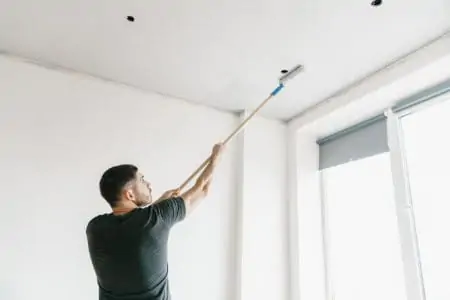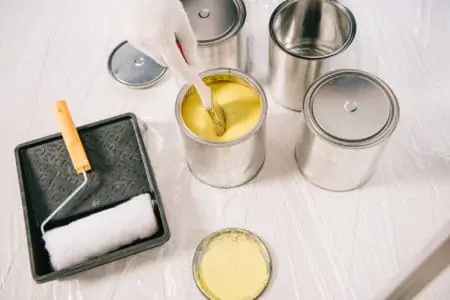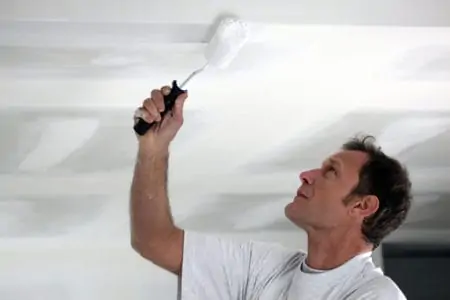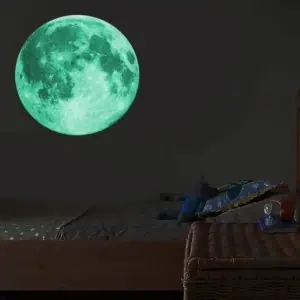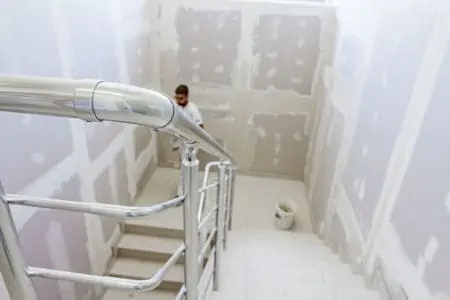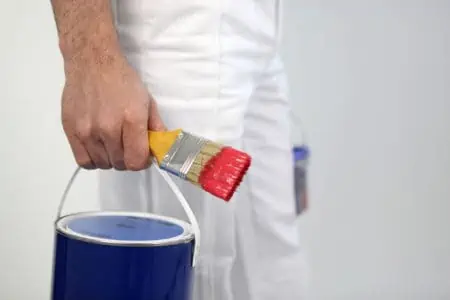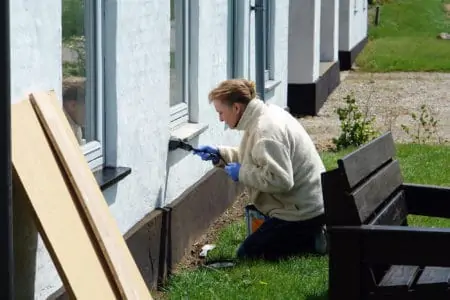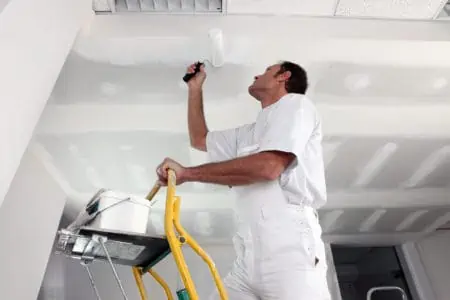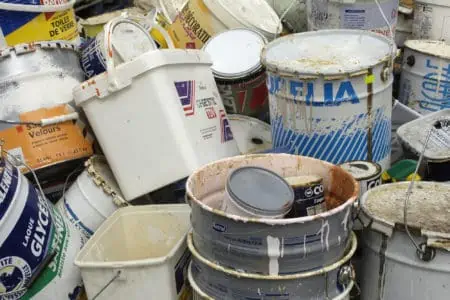Painting a ceiling sounds simple enough, but each room is different. The ceiling in your bathroom gets subjected to moisture and heat, so the paint you choose needs to have mold and mildew resistance.
We look at the best ceiling paints to determine how good they are and if they are value for money.
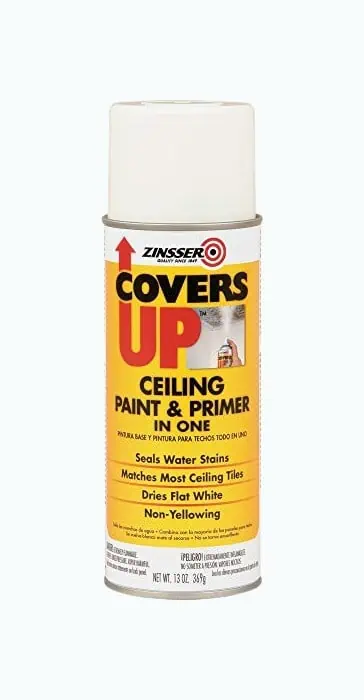
- Spray application
- Dries flat white & blends with existing paintwork
- Seals water stains and prevents them from reappearing
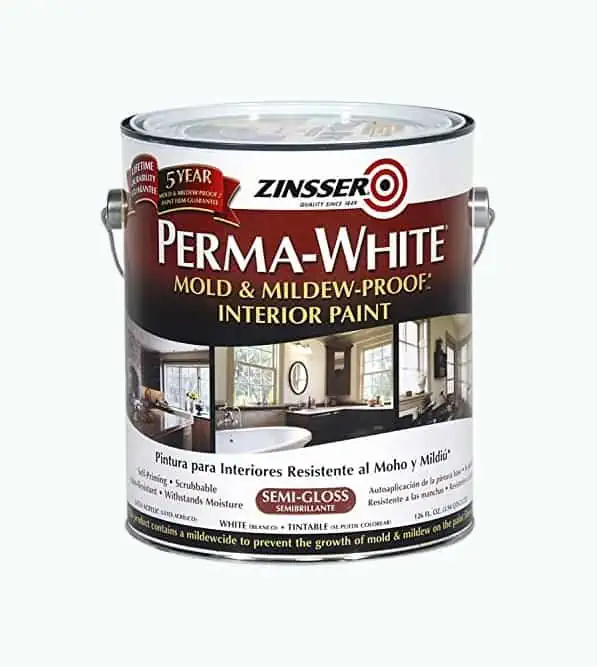
- Water-based for easy cleanup
- Safe for the environment
- Low-odor, fade-resistant, & non-yellowing
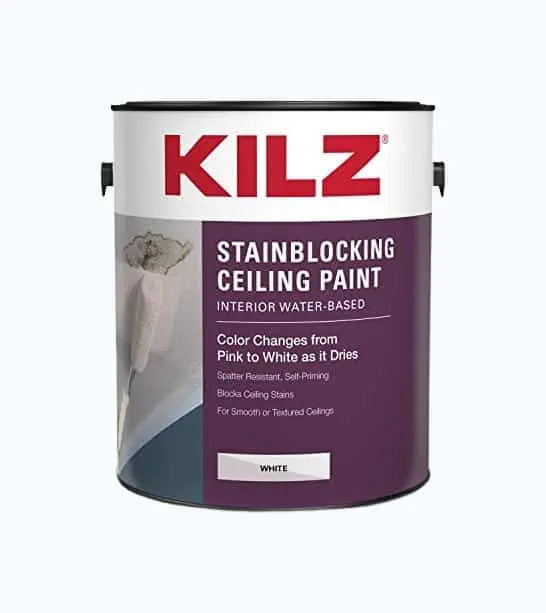
- Blocks stains
- Brush, roll, or spray it on
- Between 250 & 400 sqft of coverage
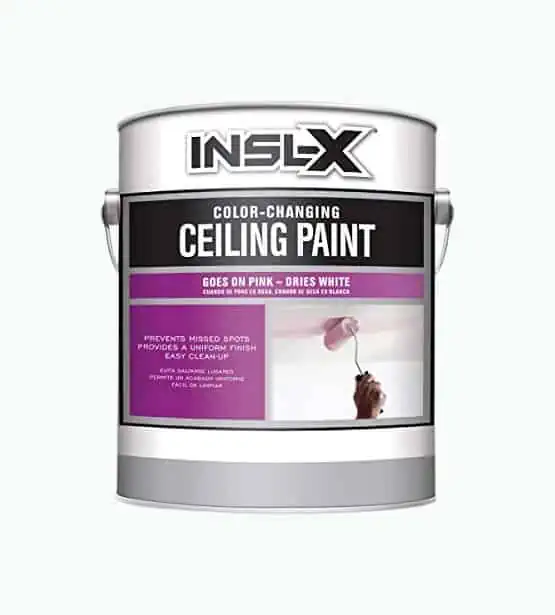
- Color-changing for easier coverage
- Dries ready for a second coat in 2 hours
- Works on plaster, concrete, cured masonry, & tile
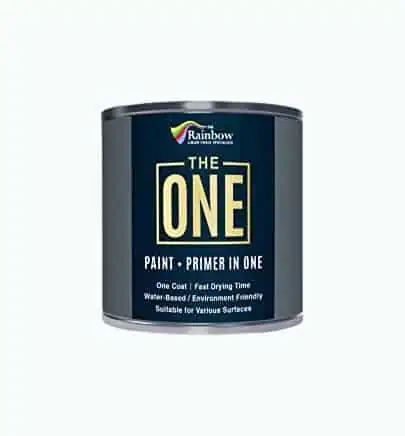
- Low in VOCs & safe for the environment
- Works on almost every surface type
- Washes clean with soap and water
Review Methodology: At Sensible Digs, we use a rigorous approach to analyze and evaluate the best ceiling paints in the market. We use professional criteria and hands-on experience to assess each product’s performance, comparing them against industry benchmarks. Our test results are based on data-driven evidence, which we use to rank and score each paint. We meticulously examine the design choices, focusing on what sets each product apart from its competitors. We provide an in-depth review, highlighting the key decision-making factors like durability, coverage, finish type, and drying time. Our findings are backed by first-hand evidence, ensuring you make an informed choice based on facts and our expert analysis.
The Best Ceiling Paints of 2024
There are thousands of paint products out there, so narrowing the field down to our favorite 5 was a challenge. Here is our take on the best ceiling paints money can buy.
Zinnser Covers Up Paint and Primer In One
Best Ceiling Paint To Cover Stains
Covering up stains on your ceiling is surprisingly difficult. The old method was to paint on a layer of PVA glue to stop mold and mildew patches showing through the paint, but this Zinnser Covers Up paint does all that for you.
This spray paint dries flat white, seals in water stains, and is non-yellowing, so it stays brilliant white for longer.
Because it goes on with a spray, it is easy to use and covers evenly. The downside with a spray can is you get overspray, and it is difficult to control when cutting in. It also comes in a 13 ounce can, so you might need a couple to complete larger ceilings. It is more of a patching paint designed to cover stains.
It is a paint and primer in one, which removes the need to spend time priming, and it applies to existing latex or oil-based paints. It’s also a great price, costing next to nothing per can, so if you need more, it won’t break the bank.
Pros
- The spray application is easy to master.
- It dries flat white and blends with existing paintwork.
- Seals water stains and prevents them from reappearing.
- Great price per can.
Cons
- Better suited to patching work.
- Spraying is difficult to control.
Product Specs
| Quantity | 13 ounces |
| Application type | Spray |
| Surface suitability | Flat and textured |
| Price | $ |
| Finish | Flat |
| Drying time | Not stated (anecdotally dries in less than an hour) |
Our Ratings
User Experience
Rust-Oleum Perma-White Mold and Mildew-Proof Interior Paint
Best Bathroom Ceiling Paint
Bathroom ceilings get more punishment than other ceilings in your home. Bathrooms are damp environments with high humidity and moisture content, so this Rust-Oleum mold and mildew paint is a welcome relief to fighting unsightly fungus stains.
This paint is self-priming and applies to any surface, even unsanded ceilings. It is also fade-resistant, non-yellowing, low odor, and tintable.
Once it dries, it is scrubbable, although if you paint it near showers, it is advisable to wait 24 hours for the paint to dry and 7 days before scrubbing. When it cures, it has a semi-gloss finish, which helps to reflect the light in the room as well as giving the ceiling a hard shell of protection.
Thanks to the water-based formula, this Rust-Oleum is easy to clean after use and safe for the environment because it has no VOCs (volatile organic compounds) that emit low-level ozone when it dries.
You also get great coverage up to 400 square feet, depending on the surface type and porosity. This is not a cheap option, costing substantially more than other similar products, but it is easily one of the top-performing bathroom paints on the market, and it also works in basements as well.
Pros
- Water-based for easy cleanup.
- Safe for the environment.
- Low-odor, fade-resistant, and non-yellowing.
- 400 square feet of coverage.
Cons
- Expensive to buy compared to other products.
Product Specs
| Quantity | 1-gallon |
| Application type | Brush or roller |
| Surface suitability | Flat and textured |
| Price | $$$ |
| Finish | Semi-gloss |
| Drying time | 30 minutes to an hour (24 hours near showers) |
Our Ratings
Personal Perspective
KILZ Color-Change Stain Blocker Paint
Best White Ceiling Paint
When you paint this KILZ on your ceiling, you might do a double-take. It actually goes on pink, but don’t fret because it dries matte white.
It dries to the touch in an hour and is ready for a second coat within 2 hours. It has a splatter-resistant formula to reduce the need for a messy cleanup, And because it is water-based, it washes off with soap and water.
This paint applies with a brush, roller, and it can even be sprayed on, although that can be wasteful and messy. For porous and textured ceilings, you get 250 square feet of coverage, and on smooth ceilings, that extends to 400 square feet.
This KILZ is a stain blocker, so it might require multiple coats to be effective, and it only tackles lighter staining. For anything heavier, you may need another product. And then there’s the cost, because this 1-gallon tin costs more than the Rust-Oleum paint, making it one of the most expensive examples to feature.
Pros
- Block light to moderate stains.
- Brush, roll, or spray it on.
- Between 250 and 400 square feet of coverage.
- Dries to the touch in 1 hour.
Cons
- Costs more than the Rust-Oleum.
- Only deals with lighter staining.
Product Specs
| Quantity | 1-gallon |
| Application type | Brush, roller, or spray |
| Surface suitability | Flat and textured |
| Price | $$$$ |
| Finish | Flatt |
| Drying time | 1 hour to the touch and 2 hours for recoats |
Our Ratings
Community Feedback
INSL-X Color-Change Ceiling Paint
Best Ceiling Paint for Popcorn Ceiling
Just like the KILZ paint, this INSL-X paint goes on pink and then dries white. The idea is that white paint is difficult to spot on a white ceiling, so the pink hue makes it easier to spot patches you have missed.
The pink starts to turn white within an hour, so you get plenty of time to apply it before it starts to dry.
The good news is this paint is ideal for smooth and popcorn ceilings. So, you don’t need to buy a separate paint when you change surface texture. It is self-priming, which speeds up the painting process, and it dries ready for a second coat in under 2 hours.
It works well on plaster, cured masonry, concrete, and tile, and because it is a water-based formula, it washes clean with soap and water. It is also better for the environment because it contains zero VOCs.
This paint is also low-odor, so you can work indoors in areas of the home with poor ventilation. The only negative is that the pink hue is so subtle, it can be difficult to spot areas you have missed.
Pros
- Color-changing for easier coverage.
- Dries ready for a second coat in 2 hours.
- Works on plaster, concrete, cured masonry, and tile.
- Water-based formula, so easy to clean.
Cons
- The pink is a little too subtle for some.
Product Specs
| Quantity | 1-gallon |
| Application type | Brush, roller |
| Surface suitability | Flat and textured |
| Price | $$ |
| Finish | Flat |
| Drying time | 2 hours for recoats |
Our Ratings
First-Hand Impression
The One Paint and Primer In One
Best One Coat Ceiling Paint
If you are struggling for time and want to get your ceiling painted quickly, this One paint is the ideal choice. It is self-priming, and thanks to the thicker formula, it only needs one coat to give an even finish.
It works on walls, ceilings, laminates, wood, metal, plastic, brick, stone, glass, and more. It is low in VOCs, making it safer for the environment, and the water-based formula cleans up with soap and water.
You can get this paint in matte, satin, and gloss, with 12 color choices to match your decor. And you can use it indoors and out. This paint comes in 250 ml tins and costs almost as much as 1-gallon of the INSL-X color-changing paint.
It means you will need to get a couple of extra cans if you have an extensive ceiling to cover, and that will be expensive.
Pros
- Low in VOCs and safe for the environment.
- Works on almost every surface type.
- Washes clean with soap and water.
- Only need one coat.
Cons
- Expensive for a small tin.
- Only suitable for smaller tasks.
Product Specs
| Quantity | 250 ml |
| Application type | Brush, roller |
| Surface suitability | Flat and textured |
| Price | $$$$ |
| Finish | Flat |
| Drying time | Fast-drying but actual time not stated |
Our Ratings
User Experience
| Product | Best | Quantity | Application type | Surface suitability | Price | Finish | Drying time |
|---|---|---|---|---|---|---|---|
| Zinnser Covers Up Paint and Primer In One | Best to Cover Stains | 13 ozs | Spray | Flat & textured | $ | Flat | Not stated (anecdotally dries in less than an hour) |
| Rust-Oleum Perma-White Mold and Mildew-Proof Interior Paint | Best Bathroom | 1-gal. | Brush, roller | Flat & textured | $$$ | Semi-gloss | 30 minutes – an hour (24 hours near showers) |
| KILZ Color-Change Stain Blocker Paint | Best White | 1-gal. | Brush, roller, spray | Flat & textured | $$$$ | Flatt | 1 hour – the touch & 2 hours for recoats |
| INSL-X Color-Change Ceiling Paint | Best for Popcorn Ceiling | 1-gal. | Brush, roller | Flat & textured | $$ | Flat | 2 hours for recoats |
| The One Paint and Primer In One | Best One Coat | 250 ml | Brush, roller | Flat & textured | $$$$ | Flat | Fast-drying but actual time not stated |
Types of Ceiling Paint
While ceiling paint barely differs from standard paint that goes on the walls, there are some considerations you need to bear in mind. Bathrooms and kitchens are subjected to higher levels of moisture, heat, and humidity, so you should choose a paint that repels mold and mildew, as well as having stain-blocking qualities.
For other rooms in the house, standard flat white paint will do. You also need to keep in mind the type of paint finish you want.
Types of Paint Finishes
While the type of paint finish is down to personal preference, there are advantages to choosing the right finish to match the room. We would recommend a shinier finish for bathroom and kitchen ceilings and a matte or eggshell finish for all the other rooms.
Matte
Matte finishes are non-shiny and dry flat. They are the perfect choice for bedroom ceilings because they don’t reflect as much light. Matte paint is ideal for rooms where there are low levels of humidity and moisture.
Flat
Flat paint may look the same as matte paint, but it has a lower gloss content, so it is completely flat when it dries. It is the ideal paint for hiding minor defects on the surface of the ceiling, and it is also scrubbable, which means you can keep it looking good for longer.
Eggshell
Eggshell paint was introduced to the United States in the early 70s, and it has been hugely popular ever since. When it dries, it has a slight sheen, so it isn’t quite semi-gloss, and it isn’t a matte finish either. The great thing about eggshell paint is it is wipeable and easy to keep clean.
Semi-Gloss
Semi-gloss paint has a higher gloss content, which gives it that high sheen. Semi-gloss paint is ideal for bathroom and kitchen ceilings because the sheen is excellent at repelling moisture. It has a wipe-clean quality that other flatter paints lack, so it keeps mold and mildew at bay.
Satin
Satin paint is also a great choice for kitchens and bathrooms because it has a glossy sheen, although somewhat less than semi-gloss. It is robust, wipeable, and stands up to scrubbing and cleaning. The downside is the sheen exposes imperfections in the ceiling.
Paint Colors
Most people paint their ceiling bright white because it lightens the room and matches any wall color, but there are no rules here. You can paint your ceiling any color you want. Just remember that if you choose a darker color, it will make the ceiling feel lower, which shrinks the room.
Color has a dramatic effect on how light and airy the room feels. Darker colors make the ceilings and walls feel closer, which is fine if you want a cozy feel, but if the room is already small, it makes it feel even smaller.
There are many shades of white available, so it doesn’t always have to be plain white; just remember that if it’s in a kitchen or bathroom, you will need to keep the ceiling clean, so the paint has to be wipeable.
How To Choose the Best Ceiling Paint
So, the time has come to paint the ceiling, but what should you focus on when choosing the paint? Let’s take a look.
Dos and Don’t When Painting Ceilings
Here are some handy tips and tricks to make your ceiling painting experience a memorable one for the right reasons.
Gather Your Tools and Equipment
Before you even think about picking up a brush, make sure that you gather all the tools you need to complete the job. Here’s what you will need:
- Drop cloths to protect everything from paint splatter.
- Extension pole for increasing the reach of your brush or roller.
- A sturdy ladder is a must for painting any ceiling.
- A paint tray is a must if you are using a roller. They are also handy if you are brushing the paint on.
- Painter’s tape makes cutting in easier, and it stops splatters on the walls where they meet the ceiling.
Prepare the Surface
Preparation is everything when it comes to ceilings. They are typically wide and flat, so every bump, dent, and blemish stands out like a sore thumb. Spend the time filling cracks and smoothing any rough sections before attempting to paint. You’ll thank yourself later.
Take Safety Seriously
Whenever you undertake any DIY tasks, safety is paramount. Ladders are dangerous, especially if they are balanced on uneven surfaces. If you are using a step ladder, make sure it is fully extended.
Don’t overreach because that affects your center of balance, and you could fall. And wear goggles to avoid paint splatters in the eye.
Remove Hanging Fixtures
This should be part of the prep work before painting, but remove anything hanging from the ceiling, including light fittings. If you have any wires hanging down, make sure they are isolated from the power supply and cover them in electrical tape to prevent accidents or paint splatters from getting where they shouldn’t.
Allow Drying Time
The time it takes for your paint to dry varies between paint types and the surface of the ceiling. Popcorn ceilings take longer because the paint needs to fill every nook and cranny, so it goes on thicker.
Read the instructions to determine the approximate drying times before considering the second coat. It also depends on the number of coats you need. Painting the second layer before the first is dry will leave you with a messy and patchy finish.
The type of paint helps to determine drying times, with water-based products drying faster than other paint formulas.
